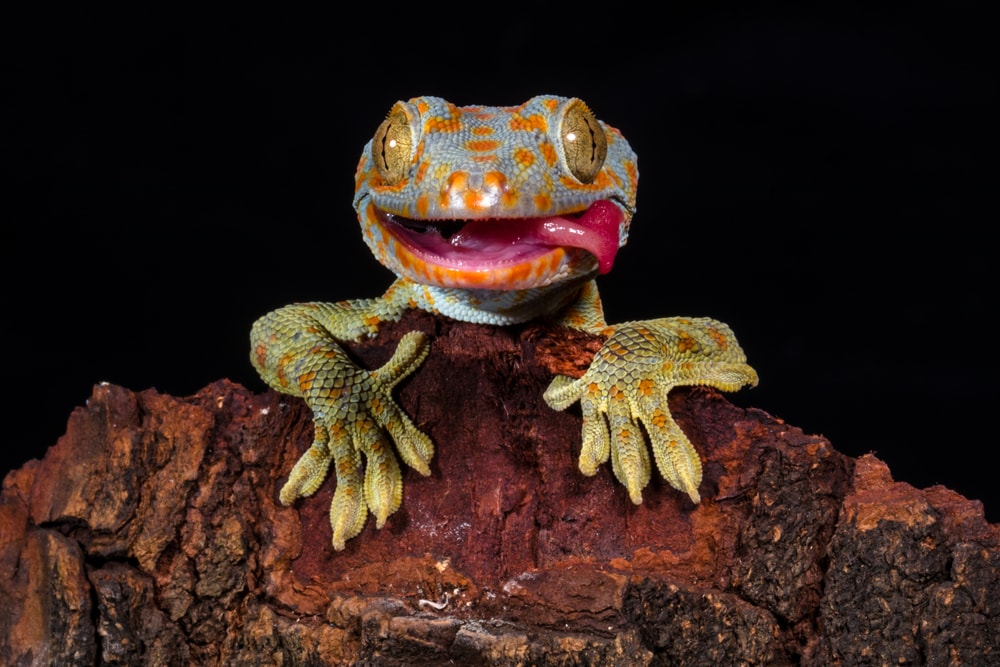
Geckos are a quirky little type of lizard. Most people are familiar with geckos, known for their “sticky” feet, grabby toes, and big, lidless eyes. They are popular exotic pets and live in every state in the US. There are over 1500 species of geckos throughout the world. They are nocturnal, carnivorous lizards found on every continent except Antarctica.
What makes geckos different from other types of lizards? First, they have specialized toe pads that help them maneuver on slick and glassy surfaces. Their toes are so sticky they have to flex their feet backward to unstick them! Some species have very unique toe pads that have adapted even further to their environments.
Next, they completely lack moveable eyelids! Instead, they have a translucent covering over their eyes that they lick to keep clean and moist. Last, they are extremely vocal and use chirping and clicking noises to talk to one another. Some gecko calls can be heard from several yards away!
Geckos have been culturally significant throughout the ages around the world. They are considered good luck in many cultures, with people believing that if you have a gecko in your home, you will have good fortune and abundance. They are often depicted in a curled shape, symbolizing the cycle of life.
These fascinating creatures are abundant in Florida. They tend to enjoy moist, temperate climates and eat a lot of insects. Florida is the ideal place for both of those! Let’s have a look at which of these critters call Florida home and learn a little bit about what makes them special.
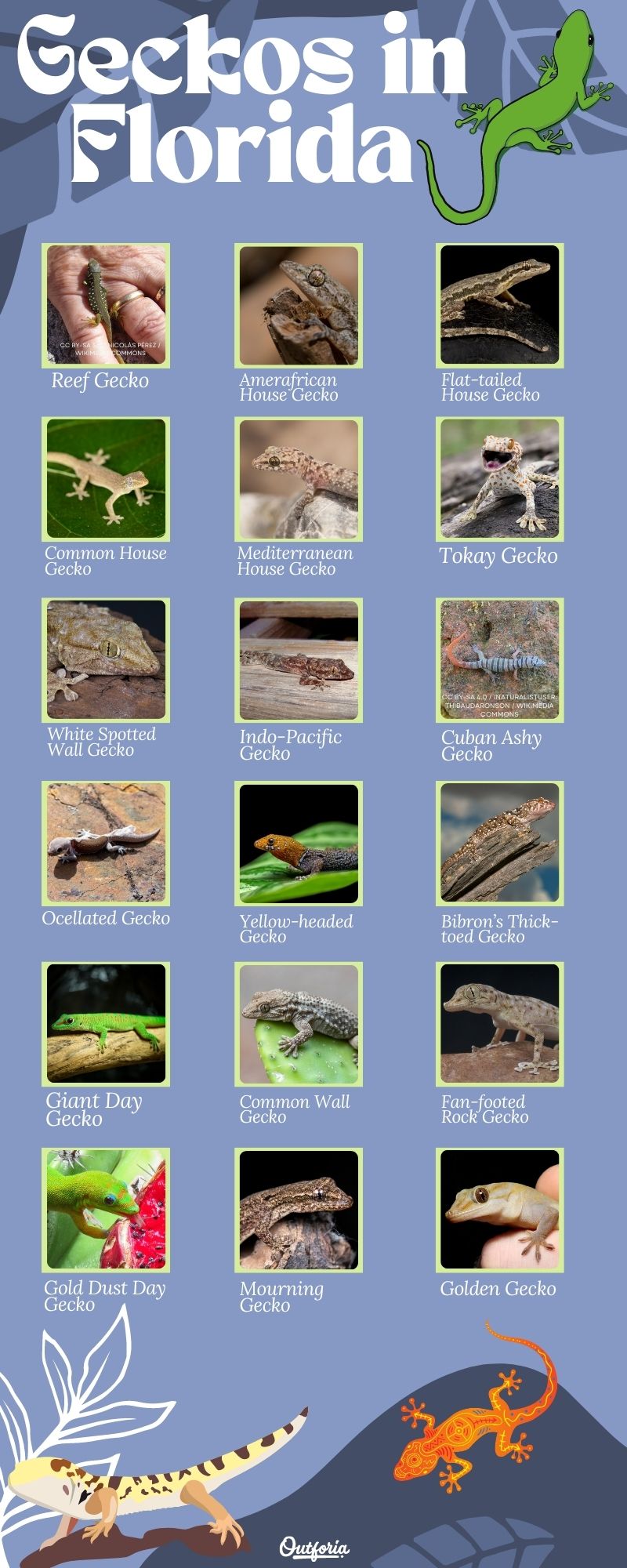
Share This Image On Your Site
<a href="https://outforia.com/geckos-in-florida/"><img style="width:100%;" src="https://outforia.com/wp-content/uploads/2022/03/Geckos-in-Florida-infographics-03182022.jpg"></a><br>Geckos in Florida Infographic by <a href="https://outforia.com">Outforia</a>You May Also Like: Check Out The Types of Florida Lizards That You Should Know About with Facts, Photos, Infographics, and more!
1. Reef Gecko (Sphaerodactylus notatus)
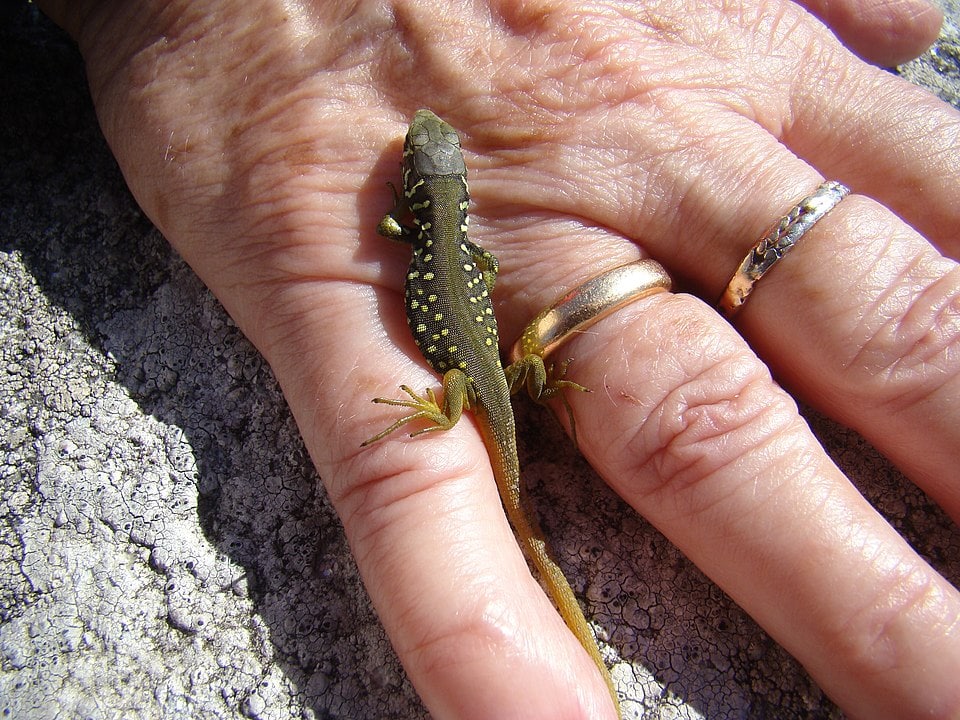
This tiny gecko is not only the smallest lizard in the United States, it’s also the only gecko native to Florida. It’s often described as matchstick-sized and doesn’t grow to more than 2.25 inches (5.7 cm). The Reef Gecko is unique in other ways, too.
Most other geckos are nocturnal and usually hunt throughout the night. The Reef Gecko prefers to be active at dawn and dusk and eats tiny insects and spiders. Its brown-on-brown coloring provides excellent camouflage as it hides in vacant lots and leaf litter.
They have dark spots on their brown skin, with females showing off 3 stripes on their heads. These teeny lizards lay only one egg at a time, and outlive most of their gecko counterparts. There are instances of them living up to 20 years in captivity! In the wild, they are likely to fall prey to other invasive geckos, and of course, humans.
2. Amerafrican House Gecko (Hemidactylus mabouia)
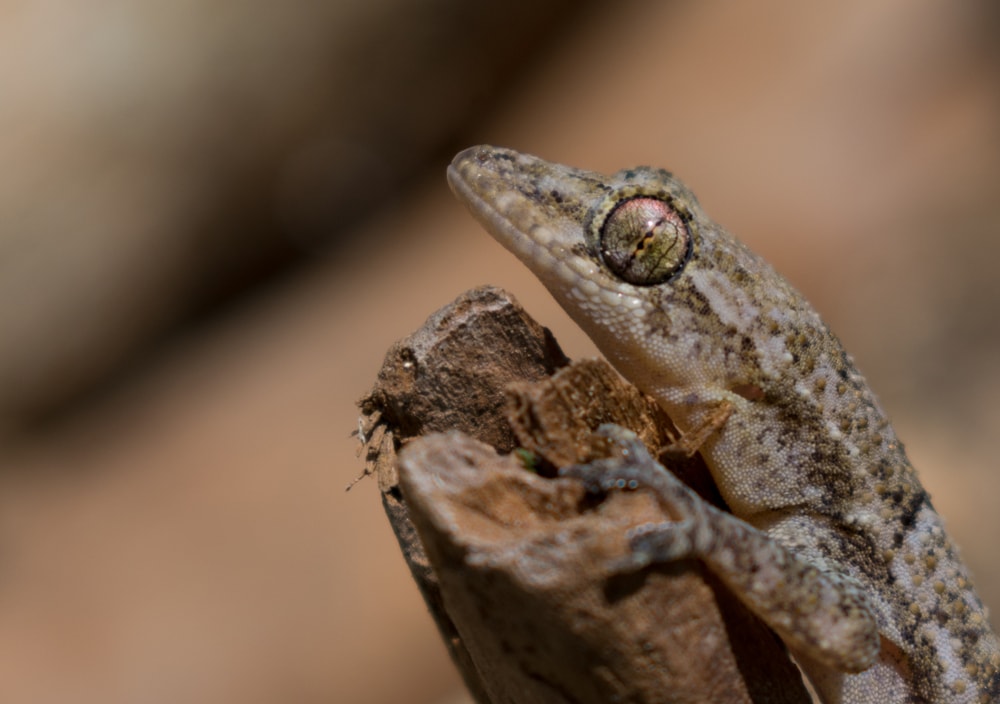
The Amerafrican House Gecko (or the Tropical House Gecko) is native to Sub-Saharan Africa but has found Florida to be a most comfortable habitat. These lizards grow up to 5 inches (13 cm) and enjoy making their home near beaches, on trees, and on walls of homes.
They are nocturnal hunters of flying and crawling insects and can change their skin color to fit their environs. They boast bumpy skin that can range from brown to gray, to pink, with chevron stripes and dark bars on their tails. They appear darker during the day, to help them hide from would-be predators.
These guys tend to be territorially aggressive, especially to the smaller, native Reef Gecko. They aren’t besties by any stretch of the word. Amerafrican House Geckos lay clutches of 2 eggs at a time, several times a season, and have a 5-year lifespan.
3. Flat-tailed House Gecko (Hemidactylus platyurus)
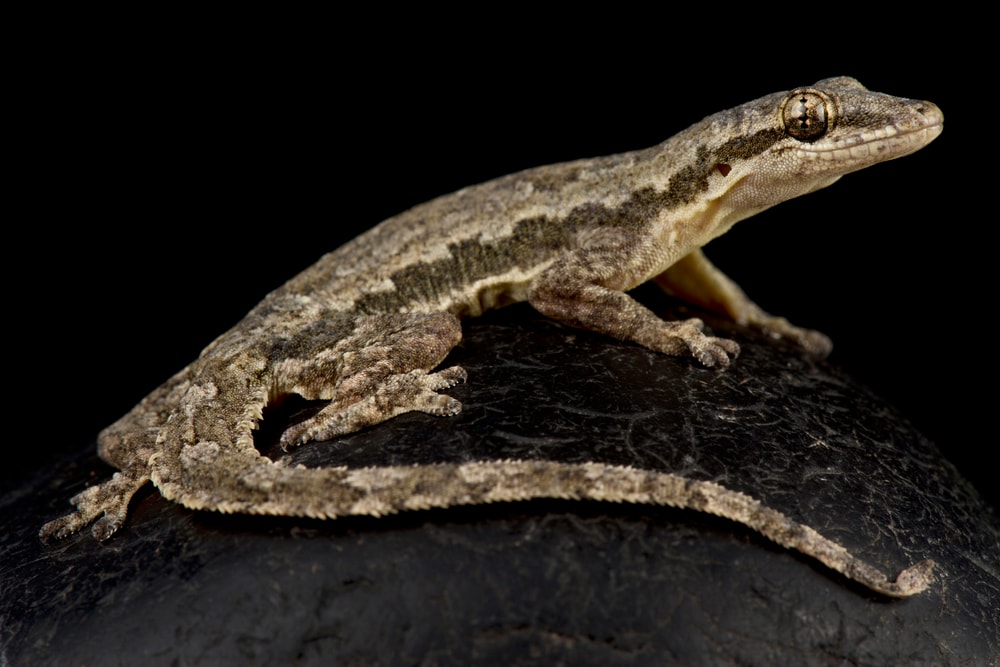
When you think of geckos, this is the one that may come to mind first. It is a very popular species sold as pets, and often referred to as a “house gecko”. These lizards are native to Asia. It was first documented in Florida in the 80s at a strip mall in Clearwater. Although it is invasive, it hasn’t taken over much terrain.
It is a small species, growing to about 3.5 inches (9 cm). They are gray with gray streaks, with white bellies, and grainy scales with fat, flat tails. It has thin flaps on the sides of their bodies that spread out to disguise their shadows and help them blend into their surroundings.
Found in urban areas, they are heavily preyed upon by the White Spotted Wall Gecko. They have minimal habitat expansion and are not aggressive or territorial. Their docile demeanor is why they make great pets.
4. Common House Gecko (Hemidactylus frenatus)
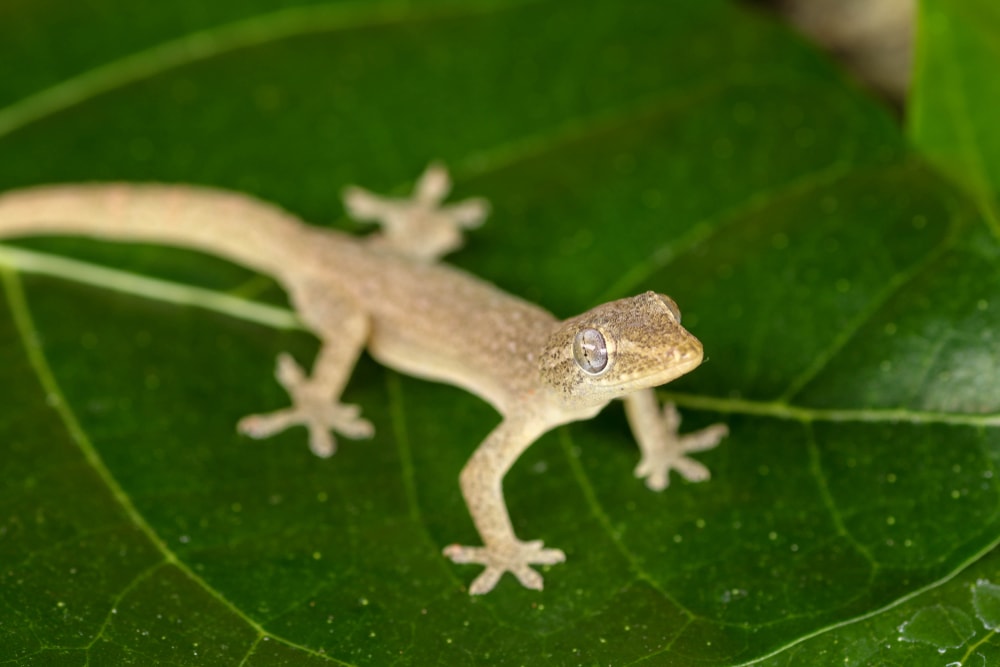
Despite its name, the Common House Gecko isn’t very common in Florida. Native to Southern Asia, and known in Florida only since 1993. Since their introduction, they have remained isolated to a few communities in Florida, namely warehouse areas near Ft. Myers, Homestead, and in the Keys.
The Common House Gecko can grow up to 5.5 inches (14 cm) and is light gray, brown, or white with rows of spines that ring around the tail. They are stealthy night stalkers and are aggressive towards other species. Their diet consists of small insects and small lizards.
They lay clutches of two eggs, live up to 5 years, and are quite territorial. They can bite but are not a threat to humans, only other lizards smaller than themselves.
5. Mediterranean House Gecko (Hemidactylus turcicus)
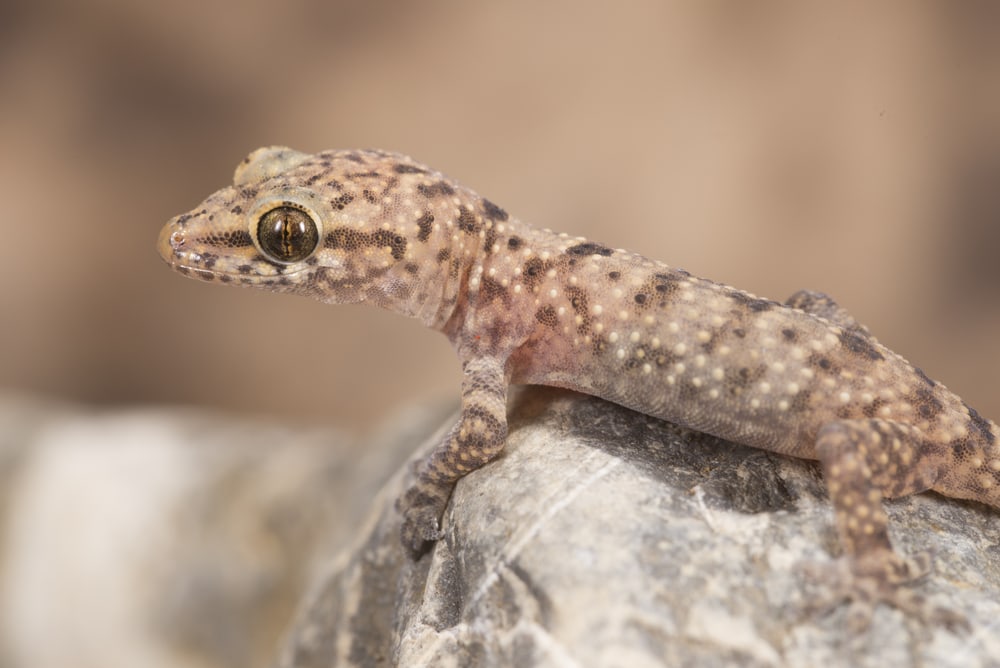
Of all the house geckos, this one is the most common. It is also the most tenacious, though its fearsome reign in Florida is being overshadowed as of late by the other varieties of house geckos.
The Mediterranean House Gecko has very warty skin, a round snout, and a flattened body. They are gray to brown, with dark spots and a translucent belly. They appear darker in the day and can be ghostly white at night. They grow up to 5 inches (13 cm) in length.
These geckos stalk their prey at night and are adept at displacing other geckos from their habitats. They are strongly resistant to pesticides and breed rapidly with multiple two egg clutches throughout the summer months.
6. Tokay Gecko (Gekko gecko)
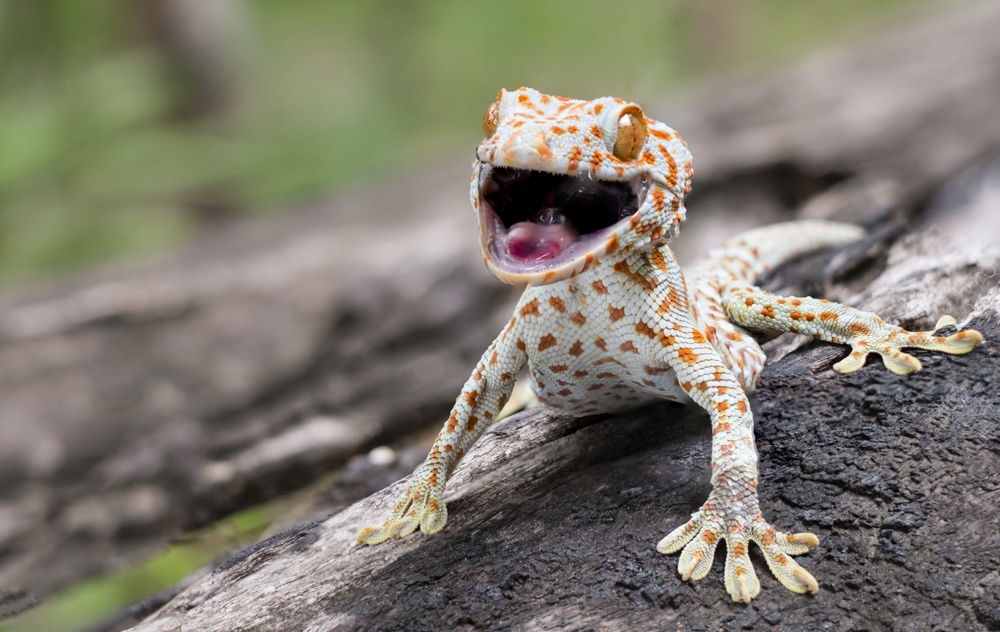
This is the largest gecko species found in Florida, coming in at a whopping 14 inches (36 cm)! These geckos even start life bigger than most full-grown adults of other varieties! These big critters have flattened bodies, big heads, beady skin and are generally pale blue to green-gray with bright white and orange spots across their entire bodies.
They aren’t much for hiding or being quiet. They have loud, distinctive calls that can be heard from many yards away. They are very territorial and can be aggressive and have a powerful bite that can result in immediate bleeding. They eat large insects, frogs, and other lizards.
The Tokay Gecko population in Florida is the direct result of escaped or released pets. These geckos have the potential to decimate native populations of lizards and frogs but are still quite isolated in their range.
7. White Spotted Wall Gecko (Tarentola annularis)
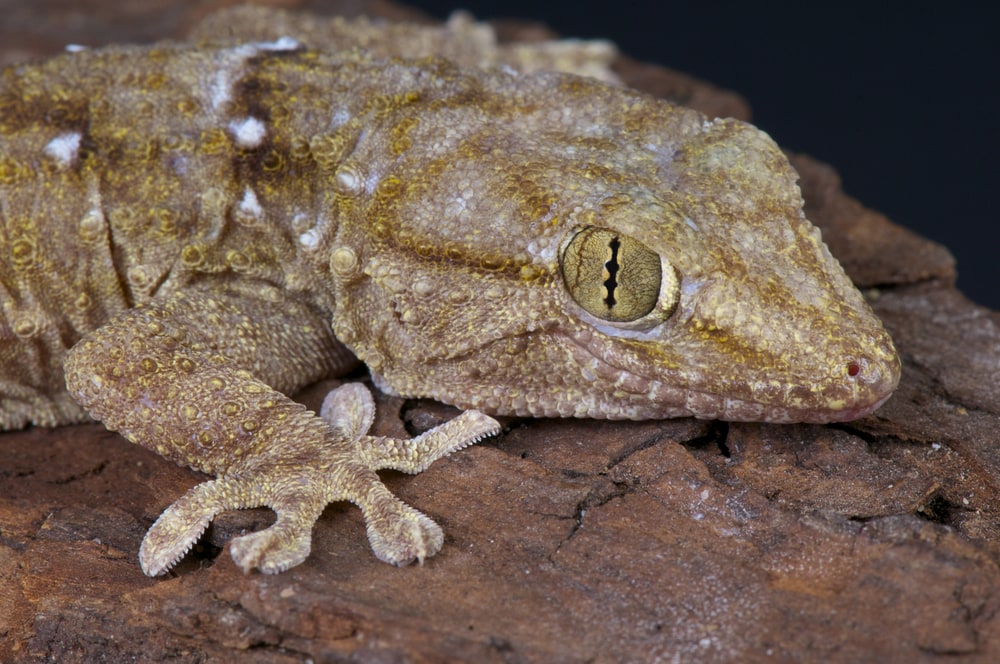
This giant gecko grows up to 6 inches (15 cm) and has raised scales on its legs, swirls of scales on its tail, giving it an armored appearance. They are gray to tan with two white spots on each shoulder and a white belly. It has big toe pads and distinct bulging eyes.
They live on walls, lay 1-2 egg clutches, and prey upon insects and other geckos. They have very isolated habitats, but reign supreme where they live. They enjoy snacking on Flat-tailed and Common House geckos and have even ousted the Tokay gecko in Tallahassee.
Native to Saharan and Sub-Saharan African, they have been spotted in Lee and Miami-Dade counties and were reported as escaping a pet store in Tallahassee in 1999. The population there has taken over the habitat of the Tokay and has the potential to harm native lizard populations.
8. Indo-Pacific Gecko (Hemidactylus garnotii)

This species grows up to 5.5 inches (14 cm) and has a long thin snout, flat tail with saw-tooth spiny scales along the lateral edge. It is dark grayish brown with light and dark markings, with a lemony yellow to orange belly. It is often referred to as the fox gecko due to its long face. It resembles a typical anole but has the toe pads of a usual gecko.
This particular gecko is parthenogenetic, meaning it is an all-female population that lays fertilized eggs without needing to be fertilized by a male. Only two other gecko species carry this characteristic, the Mourning and Tree Geckos from Hawaii.
Native to India through Southeast Asia and the Polynesian Islands, the Indo-Pacific Gecko came to Florida by hitchhiking in plants and building materials. It is well established in Southern Florida from the Keys to Lake Okeechobee and along the Eastern Coast.
9. Cuban Ashy Gecko (Sphaerodactylus elegans elegans)

This is a dwarf species, and boasts being the largest of the dwarf variety. It grows up to 2.75 (7 cm) and is covered in salt and pepper spots on dark gray-brown skin. Juveniles have distinct bands along a greenish body with an orange tail. It is arboreal, preferring trees and walls to ground activity. It is active from dusk to dawn, hunting small insects near lights.
They are preyed upon by other, large gecko species – the Common House Gecko and Amerafrican House Gecko. They lay single eggs in leaf litter and debris, but sometimes in the nests of other geckos. Their eggs have been found alongside those of their predators.
Native to Cuba and Hispaniola, they have inhabited the Florida Keys since the 1920s. Their numbers have been kept in check by other non-native species, and their range has not expanded.
10. Ocellated Gecko (Sphaerodactylus argus argus)
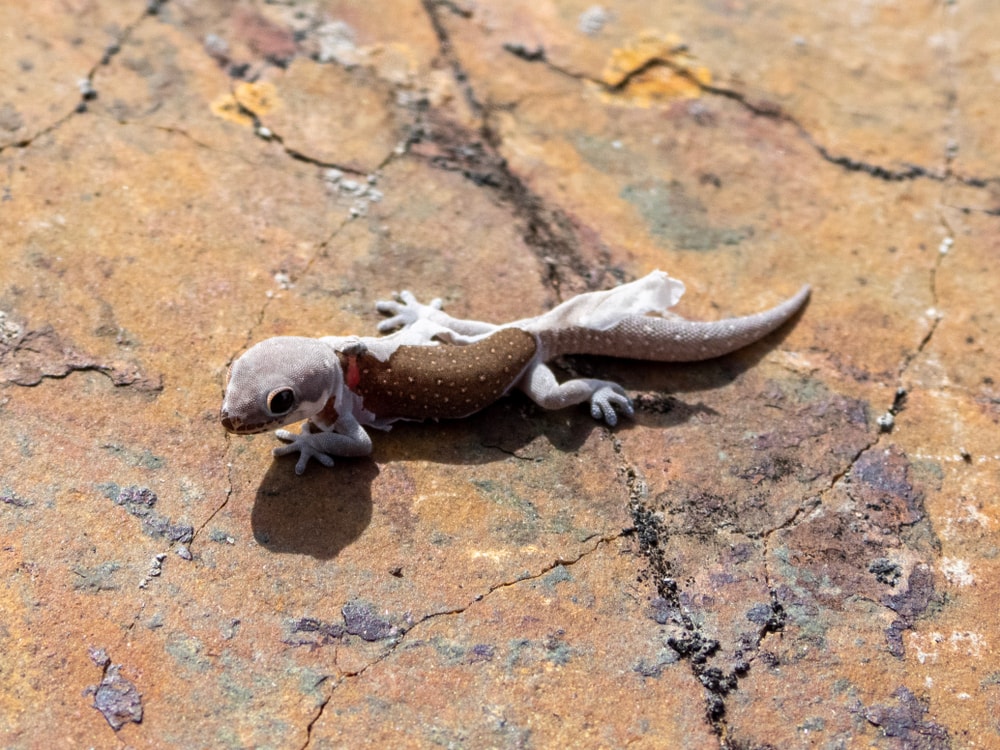
Another matchstick-sized gecko, growing to only 2.5 inches (6 cm). They are brown with tiny white spots that form lines along the body. They have eyelash-like projections over their eyes and small toe pads.
They are active at dawn and dusk, searching for insect snacks in leaf litter and debris. They prefer vacant lots to heavily populated areas and lay single egg clutches. They are considered to be quite rare and do not have an expansive range.
Native to Cuba and Jamaica, it has small populations in the Lower Keys. While they are an introduced species, they pose little to no threat to native creatures.
11. Yellow-headed Gecko (Gonatodes albogularis)
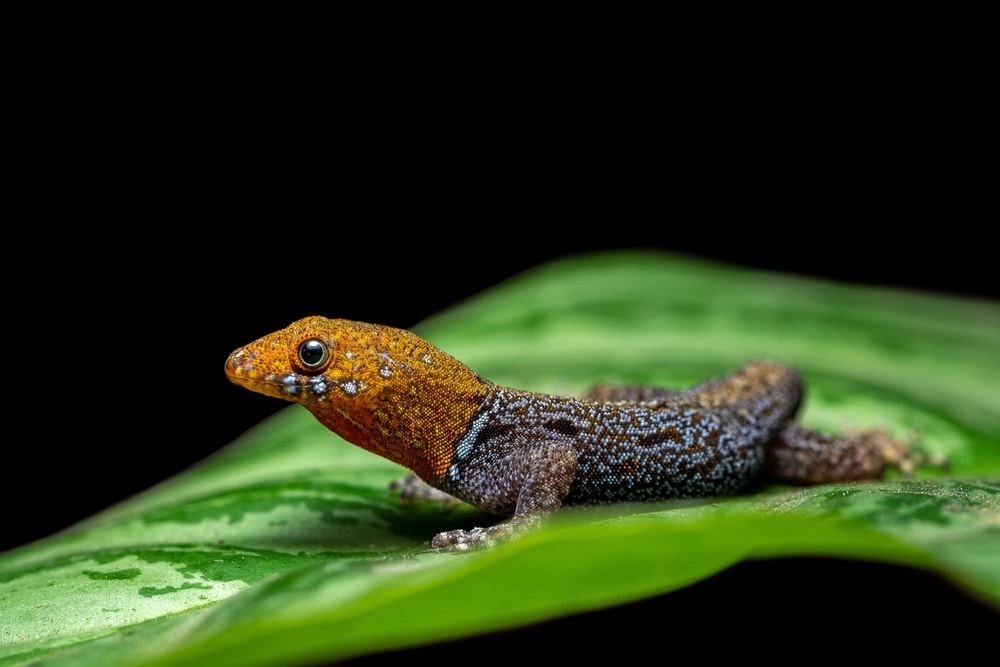
These geckos have distinct colorations and are sexually dimorphic, meaning the males are much brighter than females. The males have yellow-orange heads and dark blue to black bodies with white tails. While the females are mottled gray with a light collar line. These geckos grow up to 3.5 inches (9 cm), lack toe pads, and have the ability to traverse most vertical surfaces.
Not only do they lack toe pads, they also lack vocalization and prefer to be active in the daytime. They can be found darting in and out of nooks and crannies, searching for tiny insects and spiders. They are one of few diurnal gecko species and one of the two that have retained their large round eyes. The other is the Day Gecko.
Native to the West Indies and Cuba, the Yellow-headed Gecko lives solely in the Keys and Miami. They have lived in these areas for over 60 years, but have not expanded their range. In fact, they have become rare due to the introduction of much larger and more territorial species.
12. Bibron’s Thick-toed Gecko (Pachydactylus bibronii)
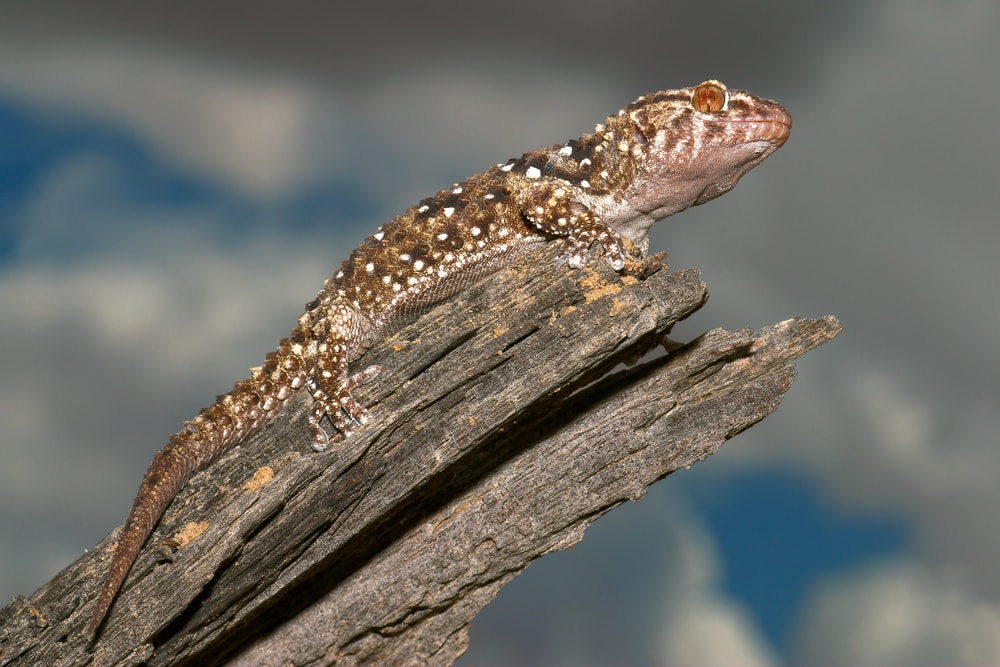
This little gecko is tan to brown or gray, with dark bars and white nodules. It has a large head, thick body, and funky feet with swollen toes. It grows up to 5.5 inches (14 cm) and looks very crocodilian in appearance.
It is a nocturnal hunter of small and large insects, and occasionally snacks on lizards. It has a powerful bite and can draw blood. They like to hang out on walls and telephone poles, waiting for an unsuspecting critter to come by. They lay 2 egg clutches.
Native to Southern Africa, the Bibron’s Thick-toed gecko was introduced in Brandon, Florida in the 1970s. It hasn’t expanded its range much and remains an isolated non-native species. They do not seem to threaten the local population.
13. Giant Day Gecko (Phelsuma madagascariensis grandis)
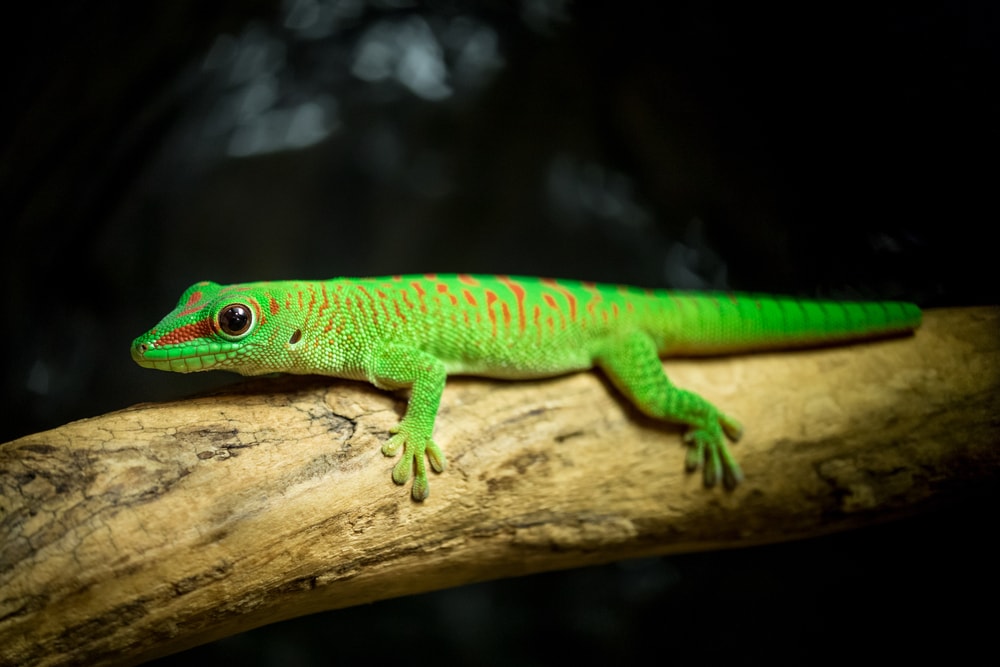
This Giant Day Gecko is exactly like its name describes. It is giant at up to 11 inches (28 cm) and it is most active in the daytime. It is bright green with red and orange streaks. It has round pupils common in most diurnal lizards. One of the very few green lizards with immovable eyelids.
They prefer climbing trees and walls to skittering on the ground, and they have a varied diet. A flexitarian of sorts, they enjoy snacking on insects, but also have a penchant for nectar, pollen, and fruit sap. This sets them apart from most of the other gecko species.
Native to Madagascar, they have been found in the Florida Keys, and Broward, Lee, and Miami-Dade counties. They are the consequence of deliberate or accidental release by pet owners or importers. It can live up to 20 years in captivity, which sadly explains why some owners just release them into the wild. It does not have a huge range in Florida, and it’s not viewed as much of a threat.
14. Common Wall Gecko (Tarentola mauritanica)
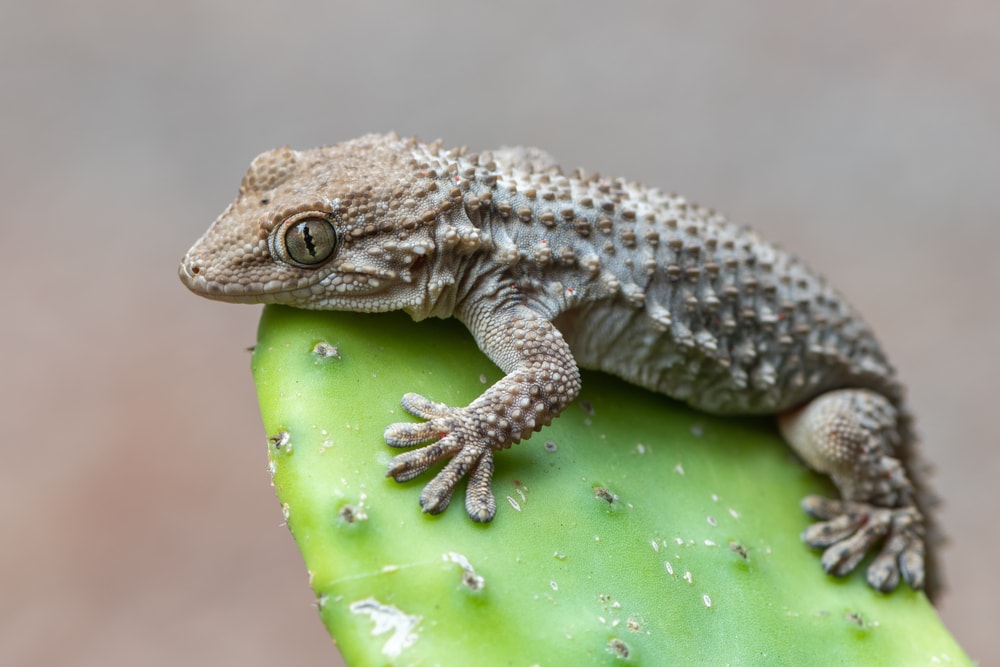
This gecko sports gold-colored vertically slit eyes, sandy gray skin with lots of tubercles, giving it a very dragon-like appearance. It grows up to 6 inches (15 centimeters) and has enlarged toe pads. They are nighttime hunters of small and large insects and can be spotted hunting on walls lit by streetlights.
Males are territorial and make squeaking noises to defend their domains. Females lay pairs of eggs twice a year in Spring and Summer. They are slow to mature and can lie up to 10 years, longer in captivity.
Also called the Moorish Gecko, they are native to the Mediterranean coast and Africa. The population in Florida has been created by the release or escape of this popular exotic pet. They have small, isolated communities in Lee and Miami-Dade counties. They are predatory but do not pose much of a threat to native lizards.
15. Fan-footed Rock Gecko (Ptyodactylus hasselquisti)
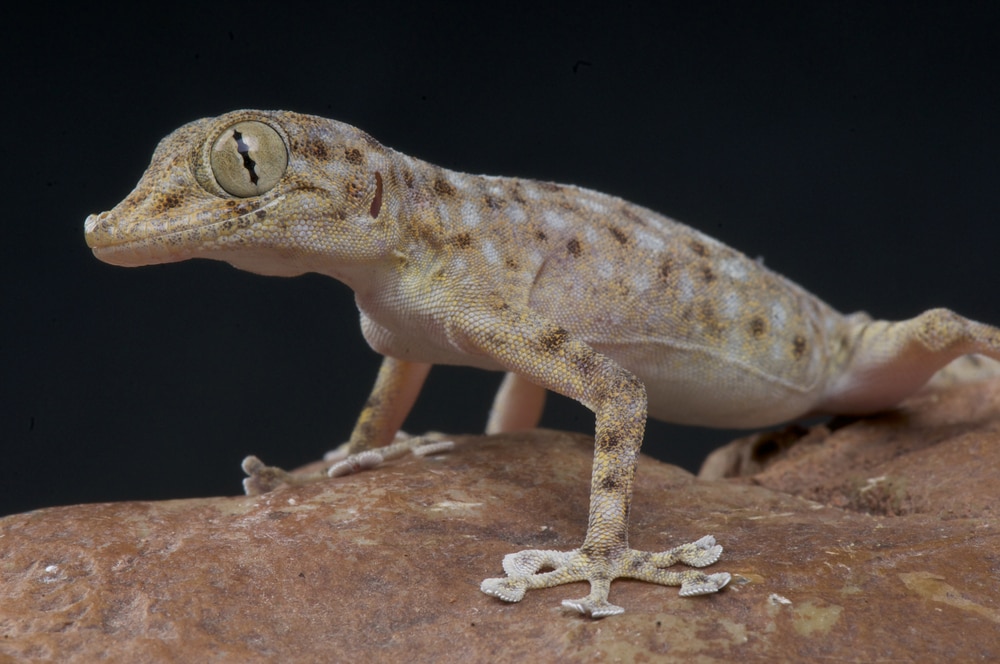
The Fan-footed Gecko grows up to 6 inches (15 cm) and is golden brown to gray, tan, or pink with dark bands on its tail and body. Its color fades to a ghostly white at night, but what makes it really unique is those toes!
You can’t miss the seriously funky feet on this little weirdo lizard! It has fan-shaped toe pads and springy hind legs like a frog. Enough to make you gasp if you happen upon him with a flashlight in the middle of the night. It is very agile and can hunt small insects on walls. When startled they will rise up and arch their backs to appear larger.
Native to Israel, Sinai, Sudan, and the Arabian Peninsula, these geckos were introduced in Gainesville in 1995 as a side-effect of the pet industry. It has not expanded its range and is confined to the local urban area.
16. Gold Dust Day Gecko (Phelsuma laticauda laticauda)
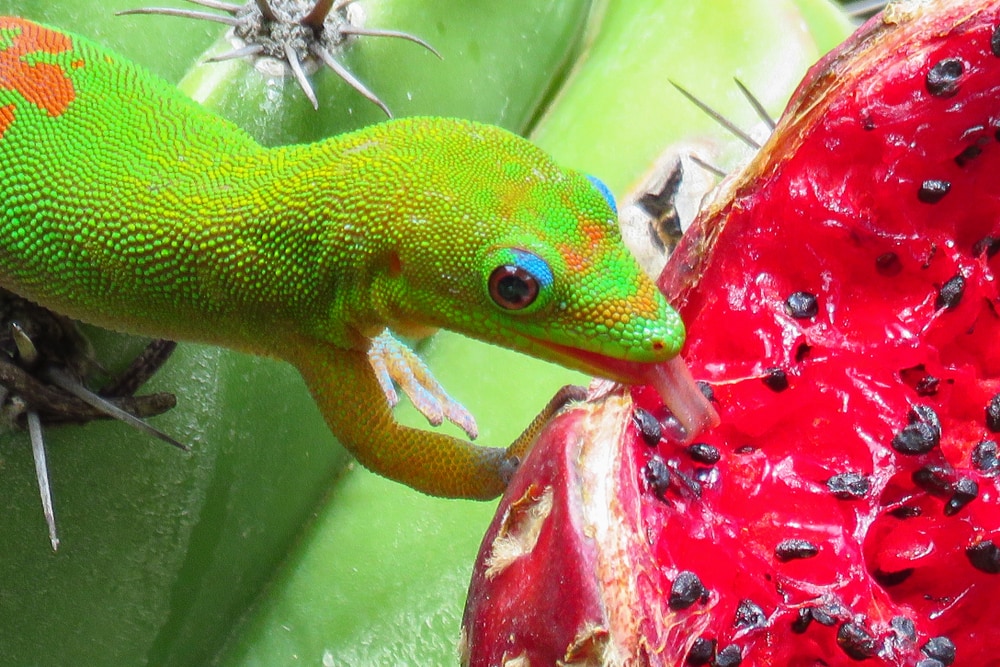
This vivid green gecko is nicknamed the “living jewel” with its bright green skin with gold dots and flashy blue and red “eyeshadow.” It’s quite the looker. It grows to be 5.5 inches (14 cm) and uses its brilliant colors to exhibit social cues.
This diurnal species is another flexitarian lizard, snacking on small insects, but also partaking in sweet treats of nectar, pollen and juices from overripe fruit. They lay 2 eggs that adhere together and are often in communal nests.
Native to Madagascar, they have been spotted in trees in the Florida Keys. They are a rare species in the area and are most likely escaped or released pets. Their small numbers show that they aren’t a threat to native creatures at this time.
17. Mourning Gecko (Lepidodactylus lugubris complex)
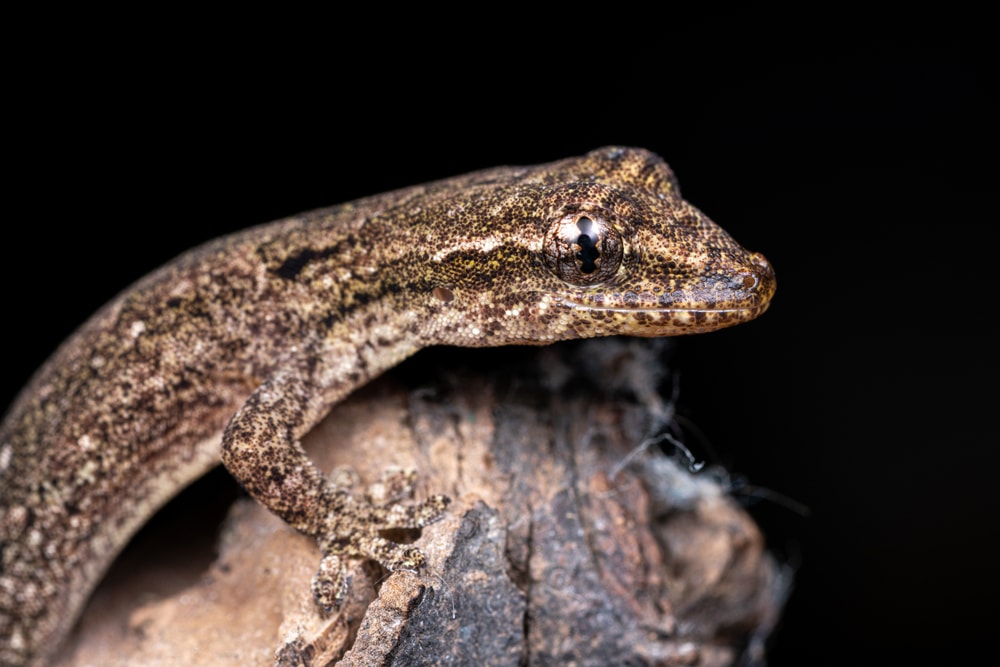
This small but chunky lizard is another parthenogenetic species. The all-female population grows to be 3.7 inches (9.5 cm) and is rather slow and bumbling. It has smooth brown to cream skin with a distinct dark line between the eyes and along the sides of its face.
They live in trees and bushes, active at night but having a flexitarian diet. They have been found in homes licking sticky sweet remnants on kitchen counters. They lay clutches of two eggs, every 4 to 6 weeks. Their eggs have been shown to be tolerant to saltwater, which may explain how they have hitchhiked across oceans.
Native to coastal regions of the Indian and Pacific Oceans, the Mourning Gecko has traveled far and wide and is now found widely across the globe. They are found in Southern Florida, and it is unknown whether they are there from the pet industry or by their own tenacious volition.
18. Golden Gecko (Gekko badenii)
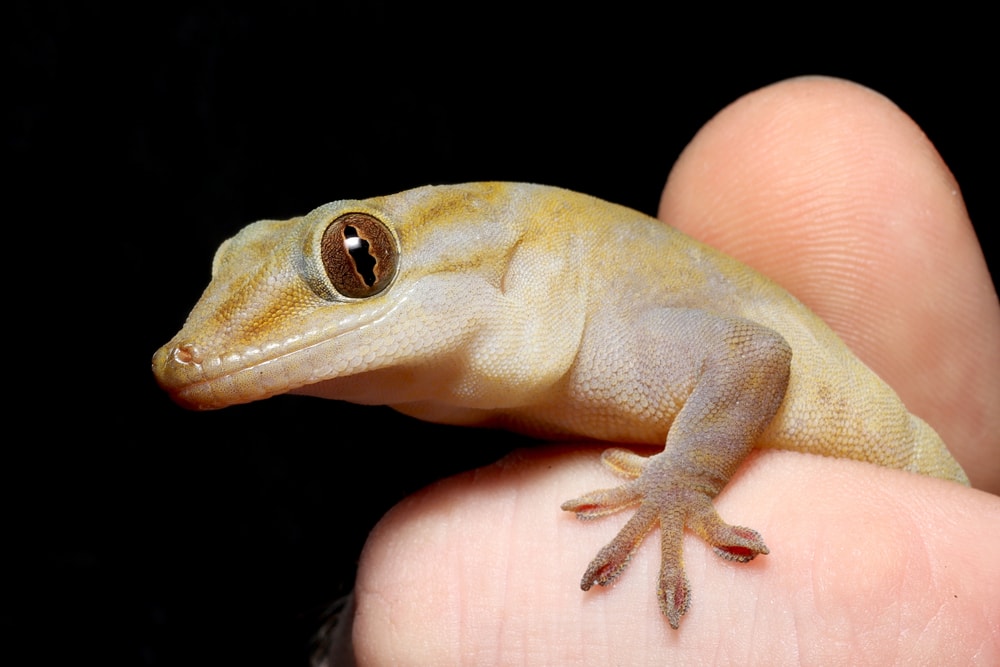
This gecko’s name says it all. The Golden gecko is golden yellow in color and grows up to 8 inches (20 cm). They have cream-colored limbs and bellies. The males have a longer tail with fleshy knobs at the base. Another sexually dimorphic species, the females tend to be smaller and not as brightly colored.
These lizards are an arboreal species, preferring to hide in trees and feed on insects and on occasion, some sweet fruit juices. They have recently become more popular as exotic pets, which explains their feral population in Florida. They are bitey critters, but hardy and easy to care for.
Native to Vietnam, they aren’t found often in the wild in the states. They live up to 10 years and as of yet, are not captive-bred. The future release of these exotic pets is predicted, and highly likely to start a larger, established community in the wild. For now, there have only been a few sightings in Hollywood, Florida.
you may also like:
Discover different species found in Florida here:

Wild Monkeys In Florida | Poisonous Frogs In Florida | Anoles In Florida | Birds Of Florida | Vultures In Florida | Woodpeckers In Florida | Hawks In Florida | Florida Freshwater Fish | Florida Frogs | Scorpions In Florida | Alligators In Texas | Sharks in Florida | Largest Alligator In Florida | Beach Birds Of Florida | Snakes In Florida | Florida Turtles | Owls In Florida | Lizards In Florida | Florida Spiders |








